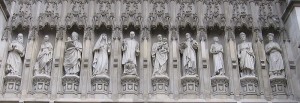
In 1998 statues of ten modern martyrs were unveiled on the West of the (Anglican) Westminster Abbey. Maximilian Kolbe, whose feast day is today (August 14), is one of them.
He grew up in Poland at the end of the nineteenth century. He decided to become a Franciscan. Fr. Kolbe set up what he called a spiritual Militia, an educational and spiritual organization attempting to combat the evils of the day. He had been studying in Rome and in 1919 Maximilian returned to Poland to become professor of church history at the Cracow seminary. He established a press to keep members of the Militia informed, and this publishing venture became a huge success. By 1927 membership in his spiritual Militia rose to 126,000 people and his printing presses moved to the capital, to Warsaw.
Father Kolbe developed a monthly magazine with a circulation of over 1 million, and a daily newspaper with a circulation of 230,000. He could be regarded as a patron of technology. He used the latest printing and administrative technologies to print and distribute his publications. Father Kolbe also started a radio station and planned to build a motion picture studio.
By 1936 he had expanded to Nagasaki in Japan and he spent some time there. But in 1936 he was called back from Nagasaki to Poland and became in charge of a friary with over 700 friars.
In 1939 Germany invaded Poland. As far as possible Maximilian dispersed the friary for safety reasons. They took in refugees. And then the German army closed the friary in September 1939 and detained some of the Franciscans including arresting Maximilian. They were released in December and again they took up helping the numerous refugees and the sick from the fall of Warsaw. Both Poles and Jews.
Maximilian began publishing again, and, given that some of the material published was critical of the Third Reich, it came as no surprise when he was arrested in February 1941. He was imprisoned in Warsaw. On May 28, 1941, Father Kolbe, in a group of 320 prisoners, was transferred to the concentration camp at Auschwitz.
He continued his caring of the other prisoners, always sharing his rations, and offered himself to be beaten in the place of others.
At the end of July 1941 a prisoner escaped from Auschwitz. The camp commandant instituted the usual reprisal: ten prisoners were to be starved to death in an underground bunker. One of the selected victims was a Polish Sergeant Francis Gajowniczek. He begged to be spared because he was worried about his family on the outside who would not survive without him when he finally got out.
Father Kolbe silently stepped forward and stood before Commandant Fritsch.
 Father Kolbe pointed to the polish sergeant, saying, “I am a Catholic priest from Poland; I would like to take his place, because he has a wife and children.”
Father Kolbe pointed to the polish sergeant, saying, “I am a Catholic priest from Poland; I would like to take his place, because he has a wife and children.”
A Witness recalled “From astonishment, the commandant appeared unable to speak. After a moment he gave a sign with the hand. He spoke but one word: ‘Away!’”
In his last days Fr Kolbe prepared the others for death. Kolbe was one of the last of the ten to die, being finally killed with an injection of carbolic acid by a camp doctor on 14 August 1941.
In 1982 in the Vatican Maximilian Kolbe was declared a saint and Gajowniczek, whose place Kolbe had taken, was present at that celebration.
Jesus said: No one has greater love than this, to lay down one’s life for one’s friends. John 15:13




Thanks for posting….he was a great saint of unbelievable courage and valor.
Beautifully told. Thank you for posting this story.
Pray for us St. Maximilian Kolbe
Fr. Maximilian Mary Kolbe….Pray for us.
That’s a totally amazing/inspiring story! The Nazis ruled by fear.And he showed no fear. Imagine if everyone had that kind of courage/faith/love.
pray for us kolbe..we also hope for an african saint soon
Not sure what you mean, Hermann – there are African saints.
Pray for us Kolbe….. Bless my son who is named Maximilian………